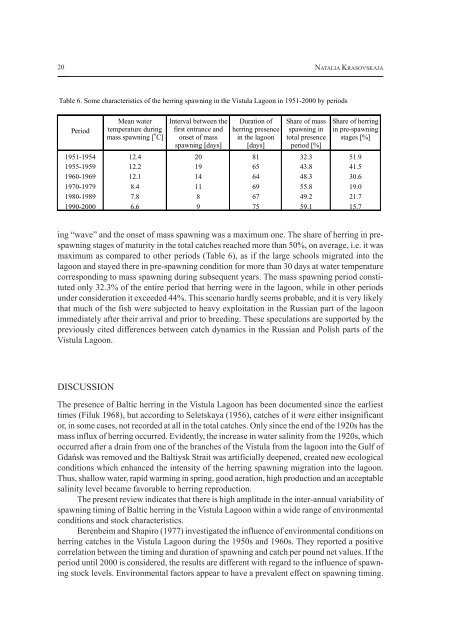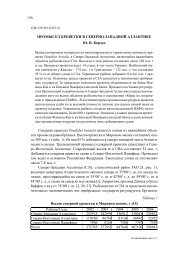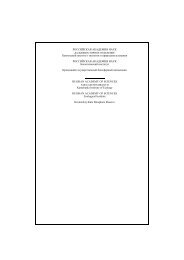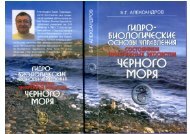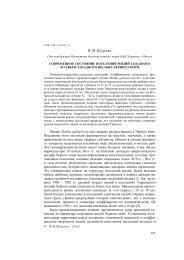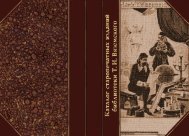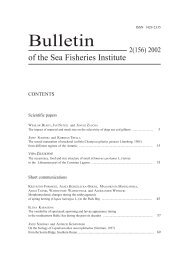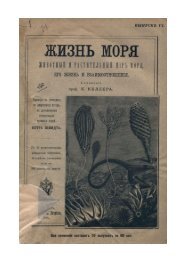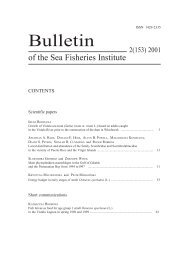Bulletin of the Sea Fisheries Institute 1 (155) 2002 - CEEMaR
Bulletin of the Sea Fisheries Institute 1 (155) 2002 - CEEMaR
Bulletin of the Sea Fisheries Institute 1 (155) 2002 - CEEMaR
You also want an ePaper? Increase the reach of your titles
YUMPU automatically turns print PDFs into web optimized ePapers that Google loves.
20<br />
NATALIA KRASOVSKAJA<br />
Table 6. Some characteristics <strong>of</strong> <strong>the</strong> herring spawning in <strong>the</strong> Vistula Lagoon in 1951-2000 by periods<br />
Period<br />
Mean water<br />
temperature during<br />
mass spawning [ o C]<br />
Interval between <strong>the</strong><br />
first entrance and<br />
onset <strong>of</strong> mass<br />
spawning [days]<br />
Duration <strong>of</strong><br />
herring presence<br />
in <strong>the</strong> lagoon<br />
[days]<br />
Share <strong>of</strong> mass<br />
spawning in<br />
total presence<br />
period [%]<br />
Share <strong>of</strong> herring<br />
in pre-spawning<br />
stages [%]<br />
1951-1954 12.4 20 81 32.3 51.9<br />
1955-1959 12.2 19 65 43.8 41.5<br />
1960-1969 12.1 14 64 48.3 30.6<br />
1970-1979 8.4 11 69 55.8 19.0<br />
1980-1989 7.8 8 67 49.2 21.7<br />
1990-2000 6.6 9 75 59.1 15.7<br />
ing “wave” and <strong>the</strong> onset <strong>of</strong> mass spawning was a maximum one. The share <strong>of</strong> herring in prespawning<br />
stages <strong>of</strong> maturity in <strong>the</strong> total catches reached more than 50%, on average, i.e. it was<br />
maximum as compared to o<strong>the</strong>r periods (Table 6), as if <strong>the</strong> large schools migrated into <strong>the</strong><br />
lagoon and stayed <strong>the</strong>re in pre-spawning condition for more than 30 days at water temperature<br />
corresponding to mass spawning during subsequent years. The mass spawning period constituted<br />
only 32.3% <strong>of</strong> <strong>the</strong> entire period that herring were in <strong>the</strong> lagoon, while in o<strong>the</strong>r periods<br />
under consideration it exceeded 44%. This scenario hardly seems probable, and it is very likely<br />
that much <strong>of</strong> <strong>the</strong> fish were subjected to heavy exploitation in <strong>the</strong> Russian part <strong>of</strong> <strong>the</strong> lagoon<br />
immediately after <strong>the</strong>ir arrival and prior to breeding. These speculations are supported by <strong>the</strong><br />
previously cited differences between catch dynamics in <strong>the</strong> Russian and Polish parts <strong>of</strong> <strong>the</strong><br />
Vistula Lagoon.<br />
DISCUSSION<br />
The presence <strong>of</strong> Baltic herring in <strong>the</strong> Vistula Lagoon has been documented since <strong>the</strong> earliest<br />
times (Filuk 1968), but according to Seletskaya (1956), catches <strong>of</strong> it were ei<strong>the</strong>r insignificant<br />
or, in some cases, not recorded at all in <strong>the</strong> total catches. Only since <strong>the</strong> end <strong>of</strong> <strong>the</strong> 1920s has <strong>the</strong><br />
mass influx <strong>of</strong> herring occurred. Evidently, <strong>the</strong> increase in water salinity from <strong>the</strong> 1920s, which<br />
occurred after a drain from one <strong>of</strong> <strong>the</strong> branches <strong>of</strong> <strong>the</strong> Vistula from <strong>the</strong> lagoon into <strong>the</strong> Gulf <strong>of</strong><br />
Gdañsk was removed and <strong>the</strong> Baltiysk Strait was artificially deepened, created new ecological<br />
conditions which enhanced <strong>the</strong> intensity <strong>of</strong> <strong>the</strong> herring spawning migration into <strong>the</strong> lagoon.<br />
Thus, shallow water, rapid warming in spring, good aeration, high production and an acceptable<br />
salinity level became favorable to herring reproduction.<br />
The present review indicates that <strong>the</strong>re is high amplitude in <strong>the</strong> inter-annual variability <strong>of</strong><br />
spawning timing <strong>of</strong> Baltic herring in <strong>the</strong> Vistula Lagoon within a wide range <strong>of</strong> environmental<br />
conditions and stock characteristics.<br />
Berenbeim and Shapiro (1977) investigated <strong>the</strong> influence <strong>of</strong> environmental conditions on<br />
herring catches in <strong>the</strong> Vistula Lagoon during <strong>the</strong> 1950s and 1960s. They reported a positive<br />
correlation between <strong>the</strong> timing and duration <strong>of</strong> spawning and catch per pound net values. If <strong>the</strong><br />
period until 2000 is considered, <strong>the</strong> results are different with regard to <strong>the</strong> influence <strong>of</strong> spawning<br />
stock levels. Environmental factors appear to have a prevalent effect on spawning timing.


